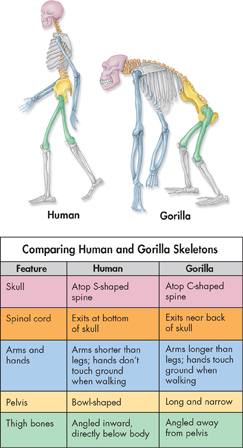▸ New World Monkeys Members of one anthropoid branch, the New World monkeys, are found in Central and South America. (Europeans used the term New World to refer to North and South America.) Members of this group, which includes squirrel monkeys and spider monkeys, live almost entirely in trees. They have long, flexible arms that enable them to swing from branch to branch. New World monkeys also have a long, prehensile tail that can coil tightly enough around a branch to serve as a “fifth hand.”
▸ Old World Monkeys and Great Apes The other anthropoid branch, which evolved in Africa and Asia, includes the Old World monkeys and great apes. Old World monkeys, such as langurs and macaques (muh KAHKS), spend time in trees but lack prehensile tails. Great apes, also called hominoids, include gibbons, orangutans, gorillas, chimpanzees, and humans. Recent DNA analyses confirm that, among the great apes, chimpanzees are humans' closest relatives.
Hominine Evolution
 What adaptations enabled later hominine species to walk upright?
What adaptations enabled later hominine species to walk upright?
Between 6 and 7 million years ago, the lineage that led to humans split from the lineage that led to chimpanzees. The hominoids in the lineage that led to humans are called hominines. Hominines include modern humans and all other species more closely related to us than to chimpanzees. Hominines evolved the ability to walk upright, grasping thumbs, and large brains. Figure 26–16 shows some ways in which the skeletons of modern humans differ from those of hominoids such as gorillas.  The skull, neck, spinal column, hip bones, and leg bones of early hominine species changed shape in ways that enabled later species to walk upright. The evolution of this bipedal, or two-footed, locomotion was very important, because it freed both hands to use tools. Meanwhile, the hominine hand evolved an opposable thumb that could touch the tips of the fingers, enabling the grasping of objects and the use of tools.
The skull, neck, spinal column, hip bones, and leg bones of early hominine species changed shape in ways that enabled later species to walk upright. The evolution of this bipedal, or two-footed, locomotion was very important, because it freed both hands to use tools. Meanwhile, the hominine hand evolved an opposable thumb that could touch the tips of the fingers, enabling the grasping of objects and the use of tools.
Hominines also evolved much larger brains. The brains of chimpanzees, our closest living relatives, typically range in volume from 280 to 450 cubic centimeters. The brains of Homo sapiens, on the other hand, range in size from 1200 to 1600 cubic centimeters! Most of the difference in brain size results from a radically expanded cerebrum.

FIGURE 26–16 Comparison of Hominoids Modern hominines walk upright on two legs; gorillas use all four limbs. The diagrams show many of the skeletal characteristics that allow hominines to walk upright. Compare and Contrast According to the chart and illustrations, what are the other skeletal differences between humans and gorillas?
ddd
Table of Contents
- Formulas and Equations
- Applying Formulas and Equations
- Mean, Median, and Mode
- Estimation
- Using Measurements in Calculations
- Effects of Measurement Errors
- Accuracy
- Precision
- Comparing Accuracy and Precision
- Significant Figures
- Calculating With Significant Figures
- Scientific Notation
- Calculating With Scientific Notation
- Dimensional Analysis
- Applying Dimensional Analysis




